The food is too good!
Authored By Brian
While the rest of the boat is out visiting the Temple of Esna here in Aswan, I am sitting in our room typing away. Last evening I came down with some stomach cramps and an upset stomach. I wanted to get some Pepto-bismol so we called the on-board doctor. This experience was not what I was expecting. Instead of dropping off a tablet or a small bottle of the pinky goodness, I was treated to a full examination lasting about 15 minutes. Dinner was about to start and I wanted to get upstairs to the dining room but instead found myself laying down on my bed and being pressed on, listened to and felt up by this guy. His technical assessment was GIT or some gastrointestinal discomfort… which sounds suspiciously like an upset stomach. He gave me a couple of pills and “permitted” me to leave the room for dinner under strict orders for no alcohol, simple foods and lots of lemon or orange juice.
The only thing I can figure out, now that it’s Thursday afternoon and I’m still feeling a bit queasy, is that the vast amount of vegetables and fruits on board must have caught me out. Since I went to London I’ve eaten very little greenery; it’s simply not prevalent in the English, French and Greek diets the way it is in my diet back home. Dr. Atkins must roll over in his grave every time someone eats at an English restaurant. This ship however has a wide variety of absolutely fantastic fruits and vegetable dishes that I’ve been loading up on over the past few days.
An English guy on board, Richard, came down with very serious stomach issues the first night we were here. No idea why although he ate the beef carpaccio (which I did as well). It wasn’t until about 24 hours later that I started to feel my cramps – about the time he started to feel much better. This is my first time in a third world country so I’m still learning the ropes of what you can eat and drink. Aboard this ship, everything should be fine, but I don’t think my body was ready for it. Today at lunch I managed to get down some chicken and rice and pretty much left the fruits alone. We’ll see how things shape up tonight.
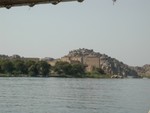 On the sightseeing front, yesterday we saw Philae Temple, a temple that was relocated about 50m to a higher island to protect it from the rising waters of the old British dam on the Nile (before the Aswan High Dam was built). These temples are so incredible with their intricate decorations literally from the floor to the ceiling (and usually on the ceiling too). Although today, after many years of flood waters and vandals and sand, there is no longer much color to be seen, occasionally a register or two in a hieroglyphic scene will still have some traces of the color. You have to remind yourself that once upon a time, the entire temple was painted in bright, vivid colors on every single carving. When you catch a glimpse of a colored register, it is awe-inspiring to think about the entire temple being this way.
On the sightseeing front, yesterday we saw Philae Temple, a temple that was relocated about 50m to a higher island to protect it from the rising waters of the old British dam on the Nile (before the Aswan High Dam was built). These temples are so incredible with their intricate decorations literally from the floor to the ceiling (and usually on the ceiling too). Although today, after many years of flood waters and vandals and sand, there is no longer much color to be seen, occasionally a register or two in a hieroglyphic scene will still have some traces of the color. You have to remind yourself that once upon a time, the entire temple was painted in bright, vivid colors on every single carving. When you catch a glimpse of a colored register, it is awe-inspiring to think about the entire temple being this way. 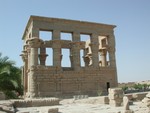 It must be something like the Sistine Chapel which was thought to be black and white until it was cleaned; revealing the colors Michelangelo had originally painted. The temples are created from great blocks of sandstone that were floated from a quarry by boat to the temple location on the Nile. These blocks come in a variety of colors like tan, brown and rose colors. The Egyptians would paint the entire wall with a white plaster to achieve a fundamental base and then lay down the bright colors to ensure consistency across the hieroglyphics. Unfortunately, plaster doesn’t last forever and when it flakes or falls off, it leaves essentially zero trace that there ever was color. It’s horribly unfortunate.
It must be something like the Sistine Chapel which was thought to be black and white until it was cleaned; revealing the colors Michelangelo had originally painted. The temples are created from great blocks of sandstone that were floated from a quarry by boat to the temple location on the Nile. These blocks come in a variety of colors like tan, brown and rose colors. The Egyptians would paint the entire wall with a white plaster to achieve a fundamental base and then lay down the bright colors to ensure consistency across the hieroglyphics. Unfortunately, plaster doesn’t last forever and when it flakes or falls off, it leaves essentially zero trace that there ever was color. It’s horribly unfortunate.
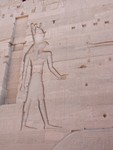 I’ve been curious about the two ways that the Egyptians would carve their hieroglyphics in the sandstone with either normal carving or relief carving. I am sure these aren’t the technical names, but I’m referring to the process of either carving into a flat piece of sandstone to achieve the shape and dimensions desired or removing sandstone to produce a relief of the shape desired. The latter would seem to be impossibly difficult with such ancient tools but the Egyptian artisans manage to, over the course of many years (the temple at Esna took 150 years to be built and thirty of those years were dedicated to decorating it), create countless amazing works. Unbelievably, you can walk up and touch the walls and feel the carvings at any time. Nothing in Egypt is protected or off-limits the way it would be in a western museum. Our Egyptologist, Hassan, is afraid that if things don’t change soon that the temples will be destroyed by the tourist traffic in the next 100 years. I’m all for preservation but it is undeniably cool to run your fingers over a hieroglyphic story more than two or three thousand years old. Now that I’ve done it, feel free to restrict access.
I’ve been curious about the two ways that the Egyptians would carve their hieroglyphics in the sandstone with either normal carving or relief carving. I am sure these aren’t the technical names, but I’m referring to the process of either carving into a flat piece of sandstone to achieve the shape and dimensions desired or removing sandstone to produce a relief of the shape desired. The latter would seem to be impossibly difficult with such ancient tools but the Egyptian artisans manage to, over the course of many years (the temple at Esna took 150 years to be built and thirty of those years were dedicated to decorating it), create countless amazing works. Unbelievably, you can walk up and touch the walls and feel the carvings at any time. Nothing in Egypt is protected or off-limits the way it would be in a western museum. Our Egyptologist, Hassan, is afraid that if things don’t change soon that the temples will be destroyed by the tourist traffic in the next 100 years. I’m all for preservation but it is undeniably cool to run your fingers over a hieroglyphic story more than two or three thousand years old. Now that I’ve done it, feel free to restrict access. ![]()
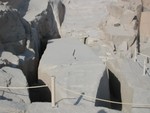 Yesterday we had a nice morning tour where we visited a granite quarry in Aswan that holds the unfinished obelisk. It would have been the largest obelisk ever created at 42m had it been finished but the artisans found several cracks in the blocks and had to abandon their project. As a result, this obelisk is ¾ quarried from the hillside lying on its side at about a 20 degree angle. Most of the area around Aswan and as much as 150km in some directions is built on granite. It’s red, black and white granite that is very strong and only exists naturally in Egypt here. The Egyptians didn’t use granite for construction but they used it for decoration and alters and statues. In most cases, granite decorates the sandstone temples around Egypt.
Yesterday we had a nice morning tour where we visited a granite quarry in Aswan that holds the unfinished obelisk. It would have been the largest obelisk ever created at 42m had it been finished but the artisans found several cracks in the blocks and had to abandon their project. As a result, this obelisk is ¾ quarried from the hillside lying on its side at about a 20 degree angle. Most of the area around Aswan and as much as 150km in some directions is built on granite. It’s red, black and white granite that is very strong and only exists naturally in Egypt here. The Egyptians didn’t use granite for construction but they used it for decoration and alters and statues. In most cases, granite decorates the sandstone temples around Egypt.
Once you lay eyes on this giant hunk of rock, the first question in my mind was how in the hell anyone planned to get that thing out. They’re literally chiseling this thing out of a solid hillside of rock and granite is not a soft stone. But here’s where those Egyptians are tricky; they used a rock called duramite from Nubia which is stronger than granite and allows them to chisel away. 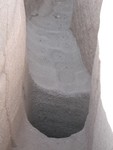 However it was not practical to excavate an entire system this way so they turned to some natural black magic. The Egyptians would start by digging holes in several places around the block they wanted to use as their source and then fill the holes with sycamore wood. Next they would fill the holes with water and the sycamore tree would expand, cracking the giant blocks of granite, and saving them endless amounts of work. Neat stuff!
However it was not practical to excavate an entire system this way so they turned to some natural black magic. The Egyptians would start by digging holes in several places around the block they wanted to use as their source and then fill the holes with sycamore wood. Next they would fill the holes with water and the sycamore tree would expand, cracking the giant blocks of granite, and saving them endless amounts of work. Neat stuff!
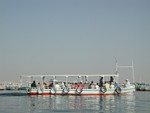 Next, we went to the Philae temple by motorboat, a temple dedicated to the God Isis. Isis is depicted as the wife of Osirus, the mother of Horus, and has two cow horns on her head. Many of these temples were “renovated” during the Greco-Roman period of rule around the third century BC, usually on top of or around much older structures that date back to two to three thousand BC.
Next, we went to the Philae temple by motorboat, a temple dedicated to the God Isis. Isis is depicted as the wife of Osirus, the mother of Horus, and has two cow horns on her head. Many of these temples were “renovated” during the Greco-Roman period of rule around the third century BC, usually on top of or around much older structures that date back to two to three thousand BC.
The Aswan high dam is destroying the fertility of the Nile river valley by preventing silt to flow downstream
Last was a quick trip to the Aswan High Dam. It’s just a dam. And there’s not much to say about it. It forms the world’s largest man made lake behind it, Lake Nasser, at 300 miles long and 10 miles wide. Of course, it is also destroying the fertility of the Nile Valley because, unlike the British dam which allowed for silt to pass through, this dam is strictly hydroelectrical. In that respect, it does well by allowing the Egyptians to export energy to their neighbors like Libya, Sudan and Palestine.
We all purchased traditional Galibyahs on our way back to the boat for the dinner last night. Everyone dressed up and we had some ethnic dancing and music led by a few of the crew members. My stomach wasn’t cooperating at the time so I sat it out, but everyone was having quite a bit of fun.
My stomach isn’t really cooperating much now either. I just took an Immodium AD and Ibuprofen acquired via the boat black market without doctor supervision and am going to lie down to let it work. Ciao!


